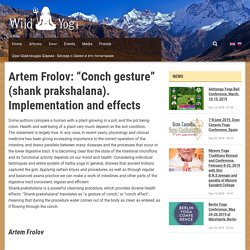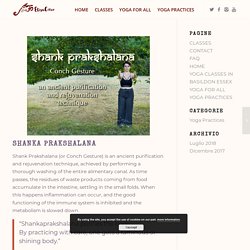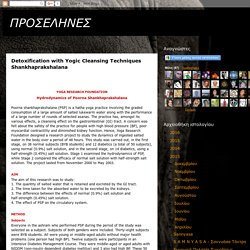

The Special Shankaprakshalana Restricted Diet. Yoga Point - Master Cleansing or Shankha Prakshalana or Dhouti (Cleansing Process from Hatha Yoga) Introduction The word Shankhaprakshalana comes from two words.

Shankha meaning "conch" and prakshalana meaning to wash completely. The word shankha is used to represent the entire alimentary canal from mouth to anus. This practice is also known as "varisar dhouti". This practice is also a part of kaya kalpa, which is an ayurvedic technique for physical purification and transformation, kaya means body & kalpa means transformation. NOTE - No one should try this in absence of Yoga Guru and without advice of medical practitioner. Pre- preparation : Plenty of clean, warm water should be available, add 2 tea spoons of salt per liter to the water and 1 lemon juice per litter. Place to practice : The best place to practice Shankhapkshalana is a garden or in an open area where there's fresh air. Procedure : Start the process early in the morning at 6 to 7am. Tadasana Tiriyak tadasana Katti chakrasana Pre position - prone position Udarakarshan Kakhpadasana Special meal More reading on Master Cleansing. Basti and Shanka Prakshalana (Complete Cleansing of the Intestines) - Hatha Yoga Kriyas.
Dhauti cleanses the upper digestive tract. Basti and Shanka Prakshalana evacuate the intestines and thoroughly cleanse the whole digestive system (from mouth to anus). Basti In earlier times Basti was performed in the river whilst sitting in a squatting position. Is Shanka Prakshalana Safe? I’ve been asked that question many times, and up until now I’ve only been able to give an answer based on theory and on my professional and personal experience with this colon cleansing technique.

(If you’re not familiar with shanka prakshalana, see my explanation here.) By theory, dangerous shifts in blood levels of sodium and potassium could result in serious health consequence. By professional and personal experience, I can say I’ve never seen it happen, not in hundreds of trials. Of course, just because I haven’t seen it, that doesn’t mean serious electrolyte shifts won’t occur depending on individual circumstances. Basti and Shanka Prakshalana (Complete Cleansing of the Intestines) - Hatha Yoga Kriyas. Shankaprakshalana - Intestinal Cleansing. Darmspülung – Shankaprakshalana - Haa International Retreat Center. „Shankaprakshalana reinigt den Körper.

Wer es gründlich ausführt, erhält einen leuchtenden Körper.” Gheranda Samhita von Shanti 1996, revidiert und erweitert Mai 2009 Vor vielen Jahren traf ich einen guten Freund auf der Straße, der mir freudestrahlend über ein Mädchen berichtete, das er gerade getroffen hatte. Und er sagte etwas, das mich aufhorchen ließ: „sie spült ihre Därme mit Salzwasser!” Katrins Weihnachtsgeschenk Fünf Monate nach ihrer ersten Darmspülung schrieb mir eine Frau: „Wie du dich sicherlich erinnerst, war ich allergisch (gegen Milch und Zucker), als ich im November bei Euch war.
Hatha Yoga Die Yogatradition ist eine reiche Tradition, die ein umfassendes Wissen über Körper und Geist enthält. Hatha Yoga umfasst verschiedene Reinigungsprozesse, die Gift- und Abfallstoffe beseitigen und die gröberen Spannungen im Körper entfernen. Ein junger Mann, der seit einigen Jahren Diabetes hatte, war für einen längeren Aufenthalt im Haa Retreat Center gekommen. Shankaprakshalana Die Diät. Artem Frolov: “Conch gesture” (shank prakshalana). Implementation and effects. Some authors compare a human with a plant growing in a pot, and the pot being- colon.

Health and well-being of a plant very much depend on the soil condition. The statement is largely true. Yoga Point - Master Cleansing or Shankha Prakshalana or Dhouti (Cleansing Process from Hatha Yoga) Shankhaprakshalana 'Cleaner Conchsiousness' Shankhaprakshalana is one of the major hatha yoga practices, coming under the heading of dhauti kriya, it is also known as varisara dhauti.

Dhauti refers to 'internal washing' and vari means 'water'. Generally the term shankhaprakshalana is applied, shankha meaning 'conch', because of its resemblance to the stomach and intestines; prakshalana meaning 'cleaning'. Shankhaprakshalana is not just a practice concerning the stomach and intestines, but is a thorough cleansing technique. It creates a repair action which affects the lungs, nervous system, skin, sinus area, the whole body, continuing while the person follows the regime of special food and asanas. In this way we see the reduction of so many disease conditions, diabetes being the most notable, and a positive step in the direction of good health. The benefit for the serious yogic practitioner is a lighter, more flexible, physical body. Shank Prakshalana yogic practice of purification - Relax and Yoga.
Shank Prakshalana (or Conch Gesture) is an ancient purification and rejuvenation technique, achieved by performing a thorough washing of the entire alimentary canal.

As time passes, the residues of waste products coming from food accumulate in the intestine, settling in the small folds. When this happens inflammation can occur, and the good functioning of the immune system is inhibited and the metabolism is slowed down. “Shankaprakshalana purifies the body. By practicing with care, one gets a luminous or shining body.”Gheranda Samhita This cleansing practice can be compared to the enema, however it is more complete because it works on the whole digestive system, while the enema does not go beyond the colon. You should choose a day when you are completely free to perform the practice, as it may take long and you may feel weak during the first few hours after the practice. This practice should be done on a completely empty stomach. Studio of SALT concentration: Detoxification with Yogic Cleansing Techniques Shankhaprakshalana.
Hydrodynamics of Poorna Shankhaprakshalana Poorna shankhaprakshalana (PSP) is a hatha yoga practice involving the graded consumption of a large amount of salted lukewarm water along with the performance of a large number of rounds of selected asanas.

The practice has, amongst its various effects, a cleansing effect on the gastrointestinal (GI) tract. A concern was felt about the safety of the practice for people with high blood pressure (BP), poor myocardial contractility and diminished kidney function. Hence, Yoga Research Foundation designed a research project to study the dynamics of ingested salted water in the body over a period of 48 hours. This study was carried out, in the first stage, on 38 normal subjects (BYB students) and 12 diabetics (a total of 50 subjects), using normal (0.9%) salt solution, and in the second stage, on 14 diabetics, using a half-strength (0.45%) salt solution. Study regarding Blood Preasure - Safety and usefulness of Laghu shankha prakshalana in patients with essential hypertension: A self controlled clinical study.